Ohio Soybean News
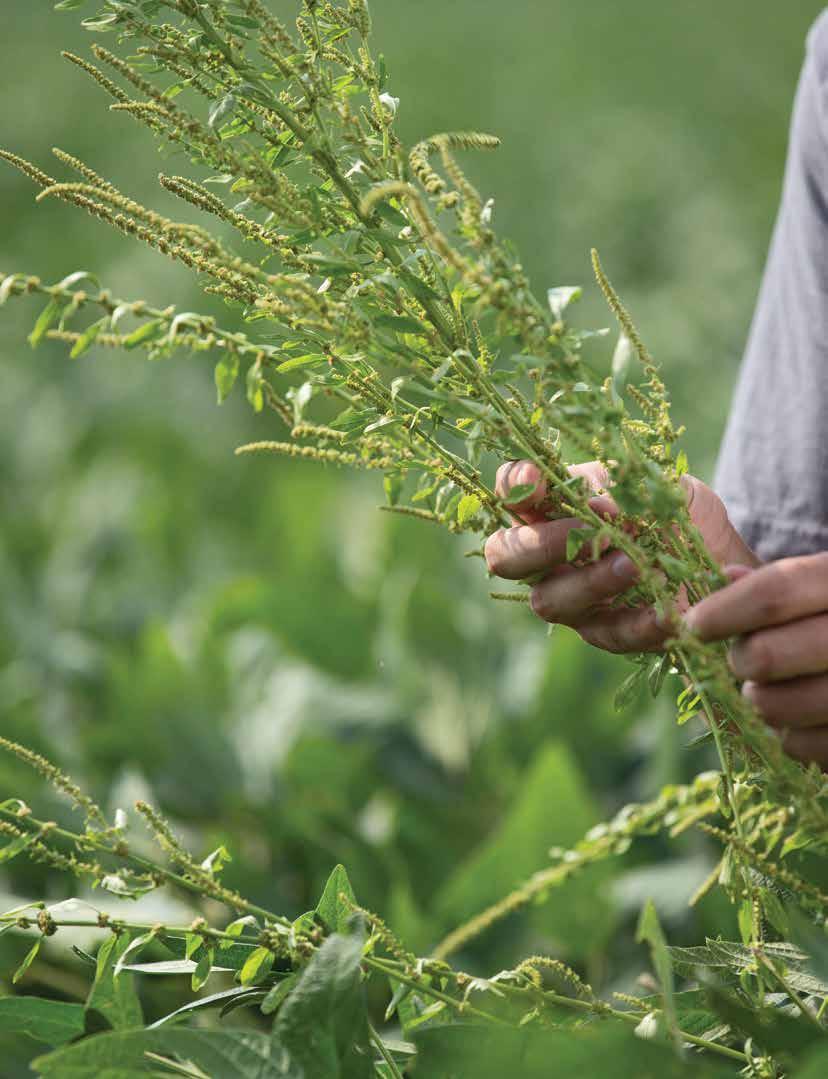
Rethinking Weed Control p.16
Participants Value Ohio State’s
Aquaculture Program p.13
All Eyes on China p. 14
Soybean Farmers Explore Alternative, Sustainable Approach to Fuel Tax p.20
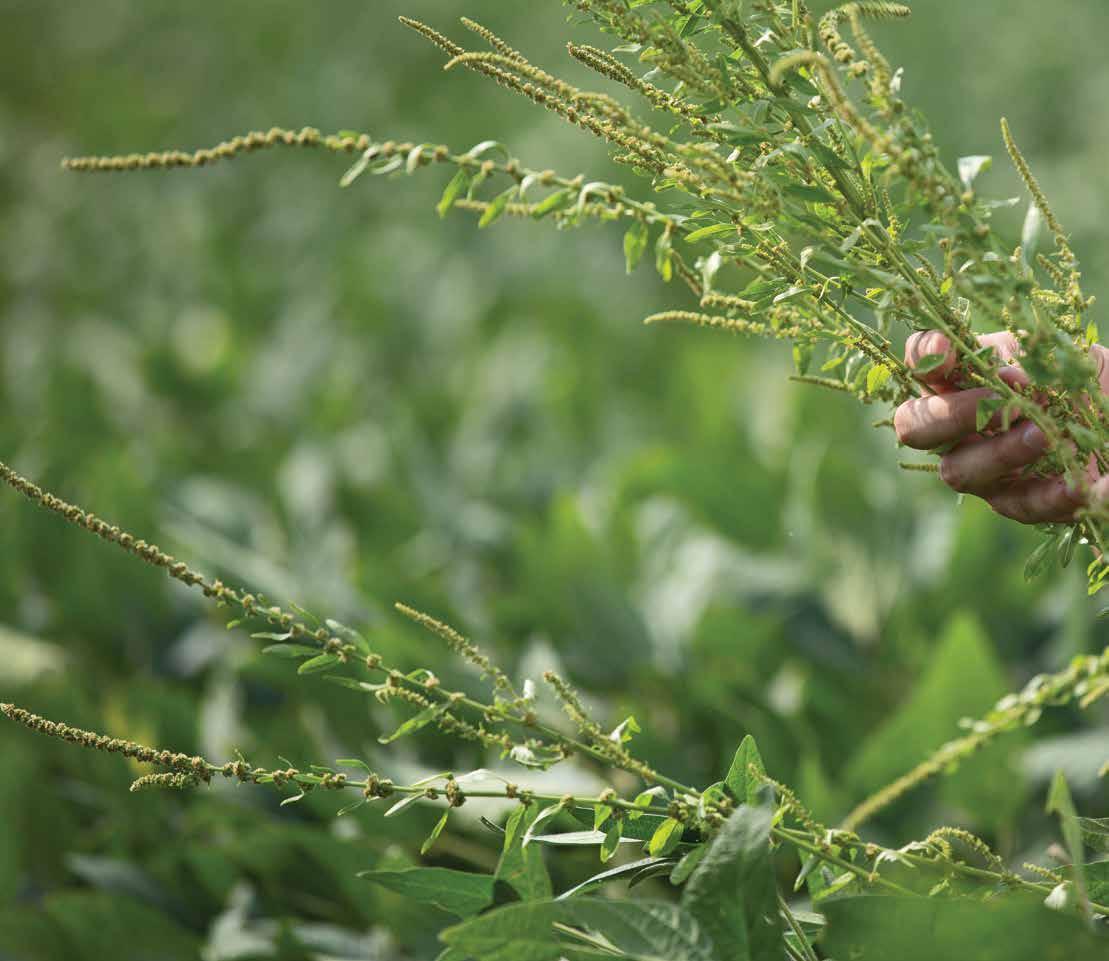
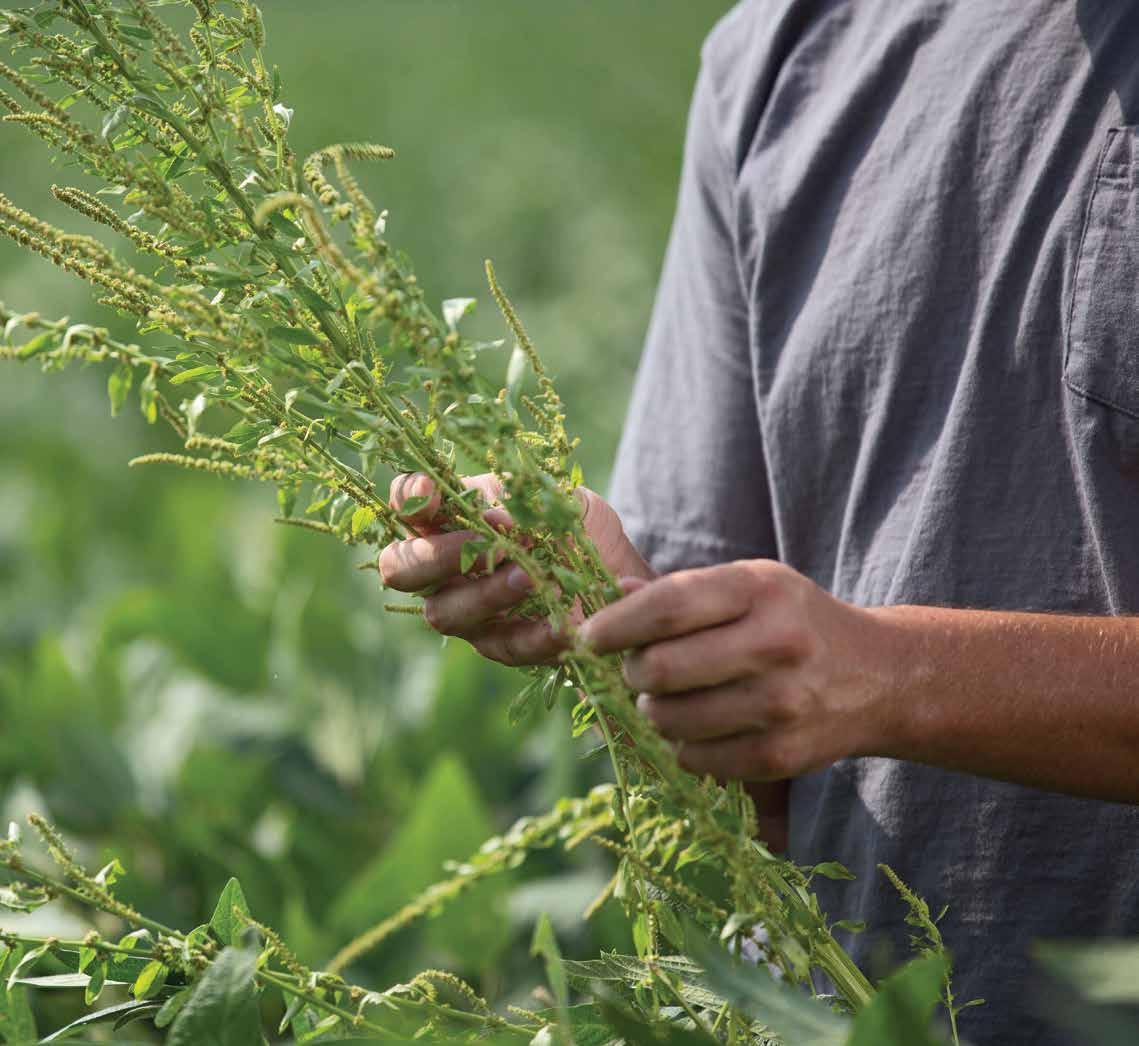



Rethinking Weed Control p.16
Participants Value Ohio State’s
Aquaculture Program p.13
All Eyes on China p. 14
Soybean Farmers Explore Alternative, Sustainable Approach to Fuel Tax p.20




Bret Davis
Ohio Soybean Association Chairman Delaware County soybean farmer
Irecently spent time in Washington, D.C. lobbying on Capitol Hill. Before leaving for Washington parts of Delaware County, including ours, saw crops standing in water. By the time I got back from D.C. we received a week of dry weather. This was the first dry week since April so it was much needed.
Each visit to Washington is different and this year was no exception. A group of Ohio Soybean Association (OSA) board members met with several legislators, legislative aides and representatives to discuss topics related to soybeans. One subject we found to be discussion-worthy was the production of biodiesel. Biodiesel is important to the economy and shouldn’t be overlooked. Renewable fuels, specifically biodiesel lower the cost of soybean meal. Therefore, as the biodiesel production increases, the price of soybean meal decreases. Livestock farmers purchase about 97% of the soybean meal we produce, making it a big market that soybean farmers should maintain and an industry that our legislators should support. As a collective group, we also presented information and updates on biotechnology, soybean exports and water quality, to name a few.
With fall right around the corner, I invite you to take advantage of two opportunities that OSA supports. First, Farm Science Review (FSR) will run September 16-18 at the Molly Caren Agricultural Center near London, Ohio. Throughout the years, FSR has been at the forefront of showcasing the future of agriculture. Be sure to stop by Friday Avenue and visit the OSA and Ohio Soybean Council building. The two organizations will have educational information on both the soybean checkoff and OSA membership.
Lastly, the American Soybean Association (ASA) is offering Succession Planning Regional Workshops. One of the workshops will be held on August 19th in Columbus, Ohio at the Renaissance Columbus Downtown. You can register up to the day of the event. For more information about the workshop, go to the American Soybean Association’s website, www.soygrowers.com.
President
Jerry Bambauer, Auglaize County
Chairman
Bret Davis, Delaware County
First Vice President
Tom Price, Putnam County
Vice President
Mike Heffelfinger, Van Wert County
Treasurer
Jeff Roehm, Highland County
Secretary
Adam Graham, Logan County
Trustees
Allen Armstrong, Clark County
John Buck, Marion County
Amy Sigg Davis, Warren County
Dave Dotterer, Wayne County
Caitlyn Heimerl, Licking County
James Heimerl, Licking County
Todd Hesterman, Henry County
Chad McIlvaine, Ross County
Lane Osswald, Preble County
Bruce Simmons, Medina County
Bob Slicker, Stark County
Jeff Sollars, Fayette County
Industry Affiliates
Kathy Alvarez, Bunge N.A.
Bill Tom, Trupointe Cooperative
American Soybean Association Board
Representatives
Bret Davis
Jerry Bambauer
Jeff Sollars
Staff Credits
Adam Ward – Publisher
Jennifer Coleman – Editor
Katie Bauer – Staff Writer
Judy Brent – Production Manager
Carol Locker – Designer
Ohio Soybean News is published six times a year by the Ohio Soybean Association, 918 Proprietors Rd., Suite A, Worthington, OH 43085 Phone: 614-476-3100. For address corrections contact Ohio Soybean News at 918 Proprietors Road, Suite A, Worthington, Ohio 43085. Web address: www.soyohio.org
E-mail: cdeboard@soyohio.org

Comments and statewide news articles should be sent to the above address. Advertising space reservations must be made by the first of the month preceding publication. In consideration of the acceptance of advertisement, the agency and the advertiser must, in respect of the contents of the advertisement, indemnify and save the publisher harmless against any expense arising from claims or actions against the publisher because of the publication of the content of the advertisement.
For Advertising Information Call: Tom Shearing
Advertising Sales Manager Phone: 585-476-2426
OHIO SOYBEAN COUNCIL
Founded in 1991 to manage the Soybean Promotion and Research Program, our primary goal is to improve soybean profitability by targeting research and development, education and promotion projects through the investment of farmer-contributed funds.
FUNDED THROUGH THE OHIO STATE UNIVERSITY TO IMPROVE SOYBEAN YIELDS AND PROFITABILITY.
YIELD-LIMITING FACTORS ARE BEING ASSESSED VIA A STATEWIDE SURVEY OF SOIL QUALITY, PESTS AND MANAGEMENT PRACTICES. THROUGH WORKSHOPS AND DIGITAL MEDIA, THIS DATA WILL BE USED TO INFORM OHIO SOYBEAN FARMERS ON HOW TO IDENTIFY YIELD-LIMITING FACTORS ON A FIELD-BY-FIELD BASIS.
Researchers will determine which non-traditional agronomic practices contribute to an increase in:
SOYBEAN SEED QUALITY OVERALL SOYBEAN YIELD PODS PER PLANT
SEEDS PER POD SEED WEIGHT

PHOSPHORUS MANAGEMENT RESEARCH WILL HELP FARMERS OPTIMIZE THEIR NUTRIENT MANAGEMENT PRACTICES.
THERE ARE 26,000 SOYBEAN FARMERS IN OHIO 1
To learn more about Ohio Soybean Council and its programs to help Ohio soybean farmers, please visit our website: SOYOHIO.ORG.
The Ohio Soybean Council (OSC) was founded in 1991 to manage the Soybean Promotion and Research Program — more commonly known as the soybean checkoff. OSC is governed by a volunteer farmer board, which directs the investments of the checkoff. The program’s primary goal is to improve soybean profitability by targeting research and development, and education and promotion projects.


Once soybeans are planted, the most valuable tools to maximize yields for farmers are their own eyes. While farmers can’t do much to help seeds grow once they’re in the ground, regular scouting is vital to getting the most out of that seed’s potential.
“I like to see farmers in the eld scouting as much as possible,” says Justin Dillon, customer agronomist for Mycogen Seeds. “It’s important that they’re out there at least every two weeks scouting, and not just through their windshield. They need to get out there in the elds.”
Pressures from weeds, insects and diseases can rob farmers of yield and prot. Keeping an eye on elds can minimize that harm.
Early in the growing season, farmers should evaluate the effectiveness of their weed control efforts, Dillon says. Determine whether the presence of weeds signals a weed ush or something more sinister — herbicide resistance. If growers catch weeds when they’re small, treatment is still usually an option. Once weeds grow too large, they can be very difcult to control.
Later in the growing season, the attention turns to the presence of diseases such as brown leaf spot or frog eye leaf spot. These foliar diseases generally don’t have much economic impact. Other diseases such as white mold and sudden death syndrome can be much more devastating, particularly as plants reach the reproductive stage.
“As soon as farmers see those soybean plants owering, they really need to pay attention and get an idea of potential impacts,” Dillon says.
To maximize the value of scouting, Dillon recommends:
o Gathering as much information as possible from multiple sources
o Looking at what’s happening in nearby states to get an idea of what might be coming
o Consulting with an advisor, agronomist or crop consultant on treatment options
o Being proactive, not reactive, in treatment
o Using the best available seed and technologies based on the challenges
“I don’t relax on soybeans until they’re in the bin,” Dillon says. “From the time they’re seed in the ground until they’re seed in the bin, farmers need to be on top of things.”


Name: Email:

By Katie Bauer
Matt Aultman comes from a long line of Ohio farmers that have a history of raising multiple crops and livestock to meet the demands of consumers. It is his continued determination and ability to embrace change over the past 15 years that has earned him recognition by the Ohio Soybean Association (OSA) and Beck’s Hybrids.
Matt was recently named second quarter winner of the Beck’s Young Farm Leader Program. Now in its second year, the program was created to recognize young Ohio farmers who showcase hard work, dedication, and leadership on and off the farm.
“Beck’s Hybrids is proud to partner with OSA on the Beck’s Young Farm Leader Program,” said Bruce Kettler, Director of Public Relations at Beck’s Hybrids. “We want to be sure and recognize young Ohio farmers who are actively contributing to the community as well as the agriculture industry.”
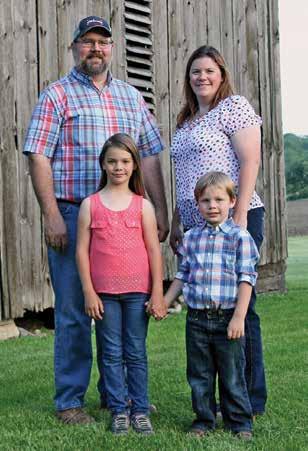
Matt, his wife Morgan, his parents, and grandparents farm 679 acres of soybeans, corn and wheat in Darke County. Although Matt is not farming full-time, he remains busy working for a family-owned grain and feed mill as the grain, feed and seed manager. The Aultman family has created a legacy as they have resided on the same land since the mid-1800’s.
“Each year we are given a clean slate to do something new or different,” regarding
his favorite part about agriculture. In addition to farming soybeans, corn and wheat, Matt also raises specialty crops for the fall market including pumpkins, gourds, squash and mums.
When Matt is not farming or working at the feed mill, he is very involved in his community and taking care of his two young children, Sophia (7) and William (3).
He serves as Chairman of the Darke County
Chamber of Commerce and the current Vice President of the Darke County Fair Board. Matt is the Cloverbud advisor of 26 children in Darke County’s largest 4-H club, columnist for a multi-county agriculture paper called “My Rural Life of Western Ohio” and one of three on the county’s Farm Service Agency committee. He sits on the Darke County Extension Advisory Council and serves as the Vice Chairman of the Adams Township Zoning Board. Matt also serves as the President of Agriculture for a Clean Environment, a bi-county conservation group.
Matt sums up his involvement by stating, “I believe if you are in the business of agriculture that you need to be involved and have a voice to protect our (farmers) way of life.”
As a soybean farmer, Matt also believes that several long-term and short-term goals are needed to build upon future opportunities.
“My short-term goal is to raise a better soybean crop through conservation and cover crop practices.” said Matt. “Implementing conservation practices will improve the land and therefore make it a more viable option for me with the higher price of land in my area.”
Matt believes it is each farmer’s duty to be stewards of their land and the surrounding properties. As a long-term goal, Matt wants to get more involved in the Ohio Certified Seed program, a voluntary certification program managed by the Ohio Seed Improvement Association. In addition, he would like to work with varieties developed

and raised in Ohio to market an Ohio Proud product.
“Supporting state research and development is the future of agriculture in Ohio,” said Matt. “Agriculture is the number one business for Ohio and this is a key to keeping it that way.”
One of the Beck’s Young Farm Leaders will be selected as the 2014 Beck’s Young Farm Leader of the Year and receive a trip for two ($2,000 value) to the 2015 Commodity Classic in Phoenix, Arizona. Beck’s Young Farm Leaders may also be chosen to attend OSA and/or Beck’s Hybrids leadership training programs, board meetings, events and other relevant activities.
“I congratulate Matt on being chosen as a Beck’s Young Farm Leader,” said Jerry Bambauer, OSA president and soybean farmer from Auglaize County. “One way Matt showcases his commitment to agriculture is through involvement with his community and OSA commends Matt on his leadership.”
Guidelines:
Growers must be between the ages of 21 and 45
Any soybean grower may apply for the Beck’s Young Leader Program; selected participants are required to have a current Ohio Soybean Association membership.
Applicants are not required to grow Beck’s Hybrids products to be eligible to win.
Applicants should demonstrate an interest in pursuing leadership roles within the soybean industry.
August 1, 2014: 3rd Quarter Applications Due October 31, 2014: 4th Quarter Applications Due Apply online at www.soyohio.org/becksyoungfarmleader
Nominate someone by contacting Adam Ward at award@soyohio.org


OBy Jen Del Carmen, Staff Writer, USSEC
hio Soybean Association (OSA) Board Member and American Soybean Association (ASA)
Director Bret Davis was part of a U.S. soy delegation led by the U.S. Soybean Export Council (USSEC) that recently traveled to Spain from June 1-5. The team attended the CESFAC Assembly (Spanish Confederation of Compound Animal Feeds) and participated in customer meetings. The purpose of the trip was to get an overview of the U.S.’s current Spanish soy feed business and to gauge
how the U.S. market can better fill the Spanish industry’s needs in the coming years.
The delegation visited a large cooperative in Orense that mills and feeds poultry and cattle in that region. Coren Company is the largest feed company in Galicia and the fourth largest in Spain. It is a co-op of all-sized farmers producing poultry, hogs and dairy and grains. They manage the animals from inception through slaughter, along with branding some of the final products through grocery stores. The team spoke with Coren’s purchasing manager who reported that the company produces between
700,000 - 800,000 thousand metric tons (TMT) of feed yearly using three main plants. Afterwards, the team met over dinner with members of the feed industry in Santiago; these companies represent about 90 percent of the feed business in the Galicia market.
The U.S. soy delegation found that most of the soybean meal was purchased on a spot decision based on price and mostly protein content.
“It seemed that they knew of amino acid make up but only purchased on protein,” said Davis. Therefore, the team discussed the feed value of U.S. soy complex and pricing options through the
Chicago Board of Trade (CBOT).
“There is a strong perception that the quality of U.S. meal (measured in crude protein) is not as good as South American meal,” said USSEC International Animal Feed Marketing Manager Pam Helmsing. “There is some interest in amino acid profiles, but we still have work to do in changing the thinking of consumers in Spain to value meal based on amino acids.”
The team also toured Coruña Port, which is landlocked by the city, and a new port that is being built outside the city, which will have over four times the space and storage in addition to the ability to ship by truck and rail.
“This shows the value they put upon importing feed grains and protein into their country and how the country is working its way out of its fiscal problems through importing feed stuffs and exporting value added food to the EU,” said Davis. Galicia is well-situated to
import soybean meal from U.S.
The U.S. soy delegation’s main purpose in attending the CESFAC assembly was to defend the business interests of the animal nutrition industry before state bodies and authorities; the European community and international organizations; autonomous regions of Spain; local authorities; business organizations and trade union organizations. Approximately 80 participants attended the conference, which focused on a recent study regarding future strategies for the feed industry in Spain.
The soy delegation also met with USSEC consultants Dr. Gonzalo Mateos and Lola Herrera, in addition to Agricultural Attaché Robert Hanson of the Foreign Agriculture Service (FAS) at the American Embassy. The team also traveled to Vigo to meet with the commercial manager of GROUP NOGUEIRA and Zaragota to visit the Cooperative Arento and meet with its
CEO and a representative from Inspectia. They also toured a research farm and visited the farm of Arento’s president.
Davis felt that technology is one of the biggest stumbling blocks for U.S. soy in the European market.
“I feel that the Spaniards are the building block of our increase of soy imports into the EU.” He continued, “They have embraced the importance of our technology but are still a little skeptical to our reports of value of it and complete safety of it.”
He believes that the methods to “open the door further” in Spain are: on-theground understanding of the amino acid value of U.S. soy by in-country trials; training on the risk management system that the CBOT has to offer; foreign exchange of the importers to see the safety and sustainability of the U.S. soy complex; and help the Spanish to better understand the technology that is used today and in the future.
The brown marmorated stink bug (BMSB) is the newest pest of concern for Ohio soybean farmers. Adults are approximately 15 mm long and 8 mm wide with the upper side of the body appearing with mottled shades of brown and gray, and is covered with dense puncture marks. The underside of the body is white, sometimes with grey or black markings distinguishing the bug from other stink bug varieties. Their eyes are dark red and legs are brown with faint white banding.

This pest typically focuses its damage on the seed in August when plants are in their R3 reproductive stage
by direct penetration of the pod. BMSB typically reside on the outer perimeter of fields with great crop diversity or fields surrounded by trees with one to two bugs being present per plant.
Currently, BMSB damage reporting lies just under threshold. Proper application of pyrethroids or other labeled chemicals in the early nymph stages has been the best method of control for this insect.
To read more, log on to www.soyohio.org/ soybeanrewards.
Managed by the Ohio Soybean Council and soybean checkoff, the Soybean Rewards Program helps Ohio soybean farmers increase productivity, yield and profitability by providing information and research related to premium opportunities, new varieties, disease and pest management and conservation practices.
By David Battocletti, Ice Miller Whiteboard
In early June, the Ohio General Assembly finished a very active spring legislative session and wrapped up work on a number of bills before breaking for the summer. As is often the case, many of these bills moved through the House and Senate at the very end of session before being sent to the Governor for his signature. One of the bills most important to Governor Kasich was the Mid-Biennium Review (MBR) budget bill, House Bill (HB) 483. This is the largest of several measures the House of Representatives split out from Governor Kasich’s six thousand page MBR proposal that was introduced in early March. This “offyear” budget review measure dealt with many, many issues - from major policy changes to minor “tweaks.”
• HB486 – Workforce Development Reforms
• HB487 – Primary and Secondary Education Reforms
• HB492 – Tax Code Administrative Changes
• HB369 – Opiate Addiction Treatment Services



Examples of the breadth of changes adopted in HB 483 are:
• accelerating tax reductions adopted in last year’s budget bill;
• increasing set-backs for wind farms;
• adding funding for state park capital projects;
• reducing compensation for members of the Ohio Casino Control Commission: and codifying care and caging standards for restricted snakes.
As is readily apparent, there is a wide range of issues that the General Assembly deals with.
In addition to the main MBR bill, there were several other important bills enacted. They include:
• HB484 – Higher Education Reform
During the spring session, the legislature and Governor also enacted into law a few bills of specific interest to the agriculture industry. First, Senate Bill (SB) 150, a bill that requires farm operators to be certified to apply fertilizer was passed and signed into law in early June. This legislation was a result of hard work by the Ohio Soybean Association, other agriculture interests, the sponsor of the bill and the chairmen of the House and Senate Agriculture Committees to address environmental concerns but not require overly burdensome regulation.
Additionally, SB 192 was enacted into law and sent to the Governor. This legislation grants the Director of the Ohio Department of Agriculture exclusive authority to regulate invasive plant species, including the identification of invasive plants and prohibited activities. Invasive plants are defined as plants not native to Ohio whose introduction causes economic or environmental harm, as determined by a scientific study. They do not include plants grown as food or livestock feed consistent with generally accepted agricultural practices. Now that the spring legislative session is over, it is widely expected that even though the legislature may have some committee hearings during the summer, most of the activity on pending legislation will take place after the November elections. The summer legislative break likely will extend into the fall. Between now and then the Governor, the legislature and other statewide office candidates will focus on their election efforts.
After the November elections, the legislature and Governor will concentrate on identifying the legislative priorities for “lame duck” session. One of the priorities for Governor Kasich continues to be an increase in the severance tax on oil and gas. The House of Representatives passed a bill and it is under consideration in the Senate. Governor Kasich wants a stronger bill and will work to get that accomplished before the legislature adjourns at the end of the year. Any bills not passed in 2014 will need to be reintroduced and start fresh next year.

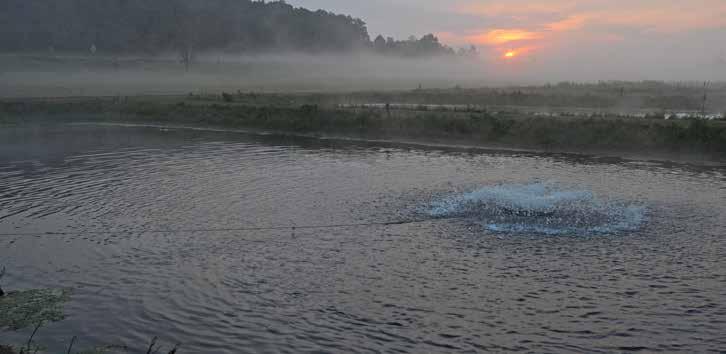
Current and future fish farmers who’ve attended aquaculture programing taught by researchers from Ohio State University’s College of Food, Agricultural, and Environmental Sciences say the techniques they learned not only increased their overall knowledge of the industry but also increased their confidence to work in this industry, according to a recent survey.
In fact, some participants said the training taught them important concepts such as how to operate a successful fish farm and helped them clarify potential obstacles to running a successful aquaponics business, said Estefania James, program coordinator for the Aquaculture Boot Camp. The program is offered by the Ohio Center for Aquaculture Research and Development at the Ohio State University (OSU) South Centers. The OSU South Centers are part of the college.
The survey is based on a two-day aquaponics program offered jointly last April by OSU South Centers and the College of Agriculture, Food Science and Sustainable Systems Aquaculture Research Center at Kentucky State University. A majority of participants, 86 percent, said the training offered there increased their skills and taught them successful strategies on how to work with both aquaponics
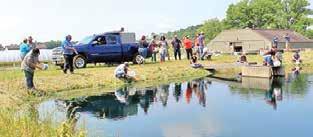
suppliers and customers, which is key to operating a strong fish farm, James said.
The workshop is just one of several training opportunities offered for current and future fish farmers at the OSU South Centers. The Centers also offers an Aquaculture Boot Camp, which provides 25 new and beginning fish farmers a hands-on approach to aquaculture and the business of fish farming through a year-long program that gives participants the opportunity to study this agricultural sector at the Piketon facility.
“We encourage our aquaculture boot camp students to actively network with new instructors and aquaculture farmers, so this workshop was a great opportunity to establish new contacts and potential business partnerships,” James said.
Aquaculture -- which includes the breeding, rearing and harvesting of plants and animals in ponds, rivers, lakes and the ocean for food, sport, bait, ornamental
Aquaculture Boot Camp, located at The Ohio State University South Centers, helps new fish farmers enhance their aquaculture skills. The program consists of three modules of training based on levels of experience.
fish, sea vegetables, fish eggs and algae -- is a strong and growing industry thanks to the increasing demand from consumers looking for healthier food options, organizers said.
In Ohio, there are about 200 fish farmers registered statewide, according to a 2010 survey by Laura Tiu, a researcher at the OSU South Centers. And many of them say they’d like to gain additional training in new and innovative production techniques, according to the survey.
During the boot camp, participants take part in 12, one-day training sessions that include workshops on aquaculture, farm tours, homework and study assignments, and the opportunity to work on an operating fish farm.
For more information on aquaculture programs offered at OSU South Centers, contact James at 740-289-2071 or 800-2972072, ext. 127, or email james.742@osu.edu.
Provided by The Ohio State University


When a customer consistently buys onequarter of an industry’s production, year after year, it’s easy to attract attention. So, considering the number of soy-related news reports coming out of China recently, it’s not surprising that some in the U.S. soy industry have been concerned.
The good news is that China has already bought 220 million bushels more soybeans than it had by early June last year, leaving U.S. soy stocks at historic lows. And, earlier this month, a Chinese delegation agreed to purchase 7 million bushels of U.S. soybeans worth an estimated $100 million. Other reports, however, indicate Chinese purchasers have been turning away ships and defaulting on orders.
Industry analysts predict that Chinese demand will remain strong, but the United Soybean Board (USB) also continues to move forward with a major project to increase demand in other
international soybean markets.
Per capita incomes continue to increase in several regions around the world, and whenever incomes improve, one of the first things those people want to do is add protein to their diets.
That’s certainly true in China, where pork production is surging and shipments of U.S. soybeans to the country have followed closely behind.
China imports more U.S. soy than all other countries put together. The country is also home to half of the world’s pork production and consumption, both of which could continue to increase. Supplying the Chinese swine sector with high-quality soybean meal will help U.S. farmers remain the preferred supplier for this valuable market.
On top of purchasing huge quantities of soybeans to use in hog feed, China reportedly overcompensated for last year’s transportation issues at harvest time in Brazil. Anticipating similar
gridlock this year, China stocked up on U.S. soybeans and soybean meal at a record pace, according to soy checkoff consultant John Baize.
As a result, U.S. soybean stocks reached their lowest levels in nearly a half-century, but the value of soybeans hit historic highs.
“This is a perfect situation for U.S. soybean farmers,” says Baize, who monitors global soybean markets for the checkoff. “They sold their soybeans early in the marketing year at very high prices. We are short now (in mid-June), but will soon be bringing in soybeans from Brazil for a much cheaper price than we sold ours for. It’s a good situation that I think we will see often in the future.”
With international demand so high, Baize believes that the value of U.S. soybeans has never been stronger.
“This is the golden age for soybeans,” he says. “We have record demand every year. Soybean demand is growing faster than demand for any other commodity. It is being driven by export demand, and
China is the biggest driver. This year, 60 percent of the crop will be exported as soybeans, soybean meal or soybean oil. That’s a record high.”
As it turns out, South American farmers have experienced a successful harvest and smooth loading conditions this year, thus inundating China with an oversupply of soybeans this spring and leading to some shipments being turned away. Some have questioned whether the No. 1 importer of U.S. soy will continue to be a reliable market, but U.S. Soybean Export Council (USSEC) CEO Jim Sutter says the market is safe for now.
“Even with the influx of shipments, Chinese crushers have been working hard to sell soybeans to other countries and delay deliveries with exporters — few have actually defaulted,” says Sutter. “Right now, the question is what export demand will look like come fall of 2014. We expect continued demand from China, but with Brazil and Argentina’s improved infrastructure, it’s likely China won’t overbuy again and export volume will be back to normal.”
Challenges that could affect China’s
future demand for U.S. soybean meal include:
A U.S. Department of Agriculture report suggests that China’s animal agriculture sector faces several challenges, which could force it to import more meat. That could be a blessing in disguise, however, if it improves demand for U.S. meat exports, as well as for domestic soybean meal demand to feed those animals.

China remains notoriously slow in approving biotechnology traits. That’s why U.S. soybean farmers representing USB, USSEC
and the American Soybean Association recently met with customers and government officials in China to discuss the importance of having a science-based approval system to maintain consistent trade and predictable timelines.
Chinese poultry farmers recently cut back on production due to a bird flu epidemic. This pushed down Chinese soybean-crushing margins for the first three months of 2014, but they’re expected to return to normal by July or August, according to Soren Schroder, CEO of Bunge Limited.
Provided by the United Soybean Board.

By Alyssa Eason
Herbicide-resistant weeds continue to threaten Ohio soybean fields, and many researchers are continuing to look for ways to help farmers fight back.
Ohio State University Weed Management Professor Mark Loux urges farmers to look past herbicide use as their sole means of preventing and controlling weeds in their fields. As he put it, “the answer isn’t in a jug.”
“It’s not possible to identify one thing that’s going to solve your issue,” Loux says. “Farmers need to have a diverse approach that not only takes into account the type of herbicide resistance they have but also that weed’s biology.”
Loux says variation is the key to any weed-management plan – both in terms of herbicides as well as other non-chemical tactics used. He adds that it’s important for farmers to understand their herbicides’ mode of action and site of action because that knowledge will help them add necessary diversity to their plan and hold off further resistance development.
The difference relates to how the herbicide works (mode of action) compared with where it works (site of action). Each represents a way to kill a weed, but each arrives at that result differently, which prevents a weed population from building resistance to any one method. By
implementing multiple modes and sites of action, herbicides will continue to be a valuable resource against herbicide-resistant weeds.
To help farmers understand these classifications, the soy checkoff leads an industry wide weed-management program called “Take Action,” which includes weedidentification and herbicide-classification charts. These materials categorize herbicides by mode and site of action to help farmers choose products from various categories.


Horseweed, also known as marestail, can produce up to 200,000 seeds per weed.
Download these materials for free at www. TakeActionOnWeeds.com.
“Anybody that deals with herbicide resistance can rely on these materials to better understand modes of action and sites of action,” Loux said.
Tom Ramsey, a soybean farmer and seed dealer from Clarksburg, Ohio emphasizes the importance of farmers mixing it up.
“The number one thing that farmers must change is their use of the same chemical programs year after year,” he said. “The



weeds will win if we don’t.”
Another important factor in preserving the use of herbicides is incorporating nonchemical control tools.
Some nonchemical strategies that can help farmers control weeds on their fields include cover crops, tillage if it is right for your fields and cleaning equipment when harvesting from field to field.
Equipment can transport weed seeds between fields. This is especially a concern at harvest when mature seeds from one field can contaminate another.
Loux also recommends implementing specific practices like scouting fields and borders, especially combined with the use of herbicides for a comprehensive weed management plan.
“When unmanaged, field borders, fence rows, creek beds and ditches can be breeding grounds for herbicide-resistant weeds,” Loux explained. “Ideally, you scout and do an assessment before each time you apply a herbicide so that you can modify your herbicide program if you need to.”
Allowing weed seed production in field borders can have long-term effects on fields. Farmers can prevent weed infestations by scouting these areas, helping reduce weed seedbanks and managing weeds before they can infest their fields.
Ramsey believes farmers need to begin changing their practices or face real consequences with herbicide-resistant weeds.
“As farmers, we think in patterns,” he says. “We load the planter the same way and start with the same fields year after year, and we can’t do that anymore. We took probably the greatest herbicide that ever existed, and within 10 years, we’ve found enough weeds resistant to it that we’ve developed a big problem.”
The risk of resistance evolution is associated with seedbank size. Keeping the soil seedbank at low levels reduces the risk of future evolution of herbicide resistance.
Loux says control could even mean going back to removing weeds from a field by hand before they get the chance to produce seed.
“I don’t care what weed it is,” Loux said, “get out there and get rid of it.”
Ramsey began his educational attack against herbicide resistance five years ago when he went to the University of Arkansas and saw soybean research plots infested with Palmer amaranth weeds. Fields that had started clean one year ago had quickly turned into Palmer breeding grounds, he says.
Ramsey understood then the real threat herbicide-resistant posed to farmers.
“When I went back the hotel I scrubbed my shoes clean,” he says. “After seeing what damage it could do, I wasn’t going to be the one who brought that weed back to Ohio.”
From that moment, Ramsey has made herbicide-resistance education a priority.
“We won’t be able to avoid these weeds forever, and it’s obvious that we won’t be able to conduct business as usual when they hit our farms.”
Both Ramsey and Loux have been in
talks about ways to help keep fields clean, and the best ways to educate farmers on herbicide-resistant weeds. They agree that it’s never too late to start fighting against them.
“It doesn’t matter when it is in the season; you can put in a prevention plan at any point,” Loux stresses.
As farmers incorporate more modes and sites of action, it’s also important for farmers to be more careful to avoid spray drift when applying these different herbicides.
Spray drift, or the movement of herbicides and other liquid crop inputs away from intended target sites through the air, has become a major concern. If a herbicide blows into a field of soybeans that haven’t been bred with resistance to that product, the unintended application could destroy the entire field, along with that farmer’s profits.
“We have chemical programs working hard to help farmers fight against these weeds,” Ramsey says. “I’m excited myself to try some new products coming out, but without proper management, they can be negative and volatile. If we misuse these, we’ll be in even bigger trouble.
“Damage to crops from spray drift can be very expensive.”
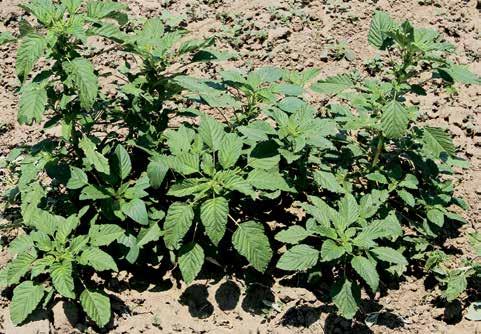



Conditions are favorable for a yieldrobbing fungus to plague soybean fields in the Midwest.
Soybean specialists urge farmers be on the lookout for white mold, and be prepared to combat the disease. Development is bolstered by wet, cool, cloudy and humid weather at flowering.
With most soybeans just starting to or about to reach the R1 (flowering) stage, experts suggest farmers spray fungicides now in fields with a history of white mold. A severe infection will weaken plants and cause wilting, lodging and death.
Daren Mueller, Iowa State University Extension and Outreach plant pathologist, said a preemptive strike is warranted since saturated soils and cool temperatures throughout much of the Great Lakes region makes white mold a viable, widespread threat. Once the disease is on plants, treatments are considerably less effective.
Yield losses of 10 to 30 percent or more in untreated fields with white mold are typical.
“It’s a very aggressive pathogen that can affect large sections of fields,” Mueller said. “This is the perfect environment for white mold.”
Farmers will want to assess the risk of white mold development to judge whether fungicides are warranted. The disease is more problematic in high-yield environments with high plant populations and narrow row spacing.
No single management strategy is 100 percent effective for white mold, and in-season options are limited. Several products that have been rated as “good” include Approach, Endura and Proline.
At best, a fungicide application will manage 50 to 60 percent of a white mold outbreak in a field, experts say.

Costs can range from about $15 to $30 per acre, officials said. The high end of the scale is for aerial application, which may be needed for saturated fields.
Weather conditions are also conducive to foliar diseases such as frogeye leaf spot, cercospora leaf blight and septoria brown spot, according to Tristan Mueller, operations manager-agronomic research for the Iowa Soybean Association’s OnFarm Network®. Fungicides that work on white mold are effective on these pathogens as well, he said.
“With the current weather patterns, it is certainly more likely that fungicides will pay compared to the last two drought years,” Tristan Mueller said.
Timing is everything when it comes to combating white mold. Damon Smith, University of Wisconsin Extension crops pathologist, said farmers often want to wait until soybeans are in the R3-R4 stage to see if there’s a problem.
“That’s too late. There’s no rescue
treatments,” Smith said.
To kill white mold, he said spraying will need to be done by mid-July.
The disease is caused by the fungus Sclerotinia sclerotiorum, which lives in the soil. It isn’t a problem every year. The last widespread issue was in 2010, which also had a wet, cool June.
As the name suggests, the disease is easily distinguished by the presence of white, moldy growth on plants. Once that’s found, fungicides are of little help.
Scouting for signs of white mold before it’s a problem is difficult. At the beginning of the disease cycle, the fungus will grow very small mushroom-like structures on the soil surface that will release spores that enter plants. The fungus disrupts the transport of water and nutrients, which reduces seed numbers and weight.
Scouting is still beneficial, officials say. Farmers can document which fields are susceptible for future management considerations.
“The risk will be fairly high this year,” Smith said.
If a soybean field has high levels of white mold it should be harvested last. To reduce fungus movement, harvesting equipment should be thoroughly cleaned.
Several resources are available to help farmers and agribusiness personnel learn about management of white mold on the new Soybean Research & Information Initiative website. Extension plant pathologists have developed a publication in collaboration with the North Central Soybean Research Program to describe the disease and optimal management strategies. “Management of White Mold in Soybeans” is available at the following site: www.soybeanresearchinfo.com
Provided by the North Central Soybean Research Program.

Many interest groups, including soybean farmer organizations, have proposed raising the tax on gasoline and diesel fuel in order to pay for needed repairs to our surface transportation system. Despite the aversion of many to higher taxes, many believe doing so would be reasonable and would provide sizable enhancement to the economies of individual states and the nation. However, many continue to agree that increasing the federal or state gasoline and diesel tax remains a challenging prospect.
A recent study funded by the soybean checkoff examines the impact of a proposed legislative concept introduced on a federal and individual state level that would primarily make the following adjustments:
1.) Immediately reduce the gasoline and diesel tax by one cent and 2.) Immediately index the gasoline and diesel tax to inflation.
“One of the most frequently expressed criticisms of the financing approach used by our nation and many states to maintain and improve our roads and


bridges is that it is not sustainable,” said Patrick Knouff, a soybean farmer from Shelby County who serves as Chairman for both the Ohio Soybean Council (OSC) and the Soy Transportation Coalition. “The costs of steel, concrete, labor, machinery, etc. go up over time, yet our nation and many states rely on a fuel tax that is fixed and does not adjust. As the cost to maintain and improve roads and bridges increases, the country and those states that utilize a fixed cent per gallon fuel tax are experiencing funding shortfalls between the needs of the surface transportation system and the revenue to address them.”
The study was performed by Indiana
University’s School of Public and Environmental Affairs and focused on three key questions:
1.) What would be the effect on the nation and on the twelve individual states* that comprise the Soy Transportation Coalition of a one cent reduction in gasoline and diesel taxes?
2.) What would be the effect on the nation and on the twelve individual states of linking the gasoline and diesel tax to inflation in 2014 in terms of annual state fuel tax revenue through 2025?
3.) How much additional revenue could have been generated in the nation and in the twelve individual states from linking the gasoline and diesel tax to
inflation the last time fuel taxes were adjusted?
Upon initial examination, the prospect of reducing our gasoline and diesel tax by any amount appears misguided given the dilapidated condition of our surface transportation system. Many believe we need more funding, not less. However, the proposal approaches this issue from a perspective of what is possible, not what is ideal. Many transportation stakeholders have concluded that the ideal has proven to be elusive up to this point and that this will likely continue into the future.
One of the widely expressed concerns with our nation’s tax on gasoline and diesel fuel is that it is not sustainable due to not being indexed to inflation. While many policymakers acknowledge the need to remedy this problem, many also desire to provide some sort of concession, albeit modest, to the taxpayer when addressing the fiscal challenges confronting the surface transportation system. The one cent reduction in the fuel tax is an example of such a concession to the taxpayer. The proposal is not an attempt to rectify all the nation’s transportation challenges. Rather, the
proposal was developed to present a more realistic chance to introduce some sustainability to our transportation financing. If achieved, many would regard this as a significant step forward.
“The research highlights that, upon implementing this proposal, the initial revenue foregone by the immediate one cent reduction can be quickly recovered,” explains Mike Steenhoek, executive director of the Soy Transportation Coalition. “For the nation and the individual states analyzed, it requires four to five years before the cumulative loss of the one cent reduction would be fully recovered. Therefore, in four to five years, fuel tax revenues would be in positive territory and increasing with each succeeding year. As a result, the need for the decision makers to routinely debate and consider adjusting the fuel tax will be significantly reduced because of the index to inflation.”
The following twelve member states
1.
A reduction in gasoline and diesel taxes by one cent per gallon without indexing to inflation would reduce revenue to the state of Ohio by a total of $63.6 million in 2014.
Projections indicate that the 2014 consumption of gasoline and diesel in Ohio will be 4.965 billion and 1.552 billion gallons, respectively. Given a one cent reduction in the gasoline and diesel tax, the immediate reduction of state revenue would amount to a total of $63.6 million.
2.
Indexing the fuel tax rate to inflation in 2014 would result in an average additional revenue per year of $140.7 million between 2014 and 2025. If fuel taxes are indexed to inflation in 2014, additional real state revenue of $340.5 million per year would be generated by 2025.
3. If Ohio had indexed the diesel tax and the gasoline tax to inflation in 2005 – the year in which they were most recently increased – an additional $1.668 billion would have
of the Soy Transportation Coalition were analyzed in the research:
• Illinois
• Indiana
• Iowa
• Kansas
• Kentucky
• Michigan
• Minnesota
• Nebraska
• North Dakota
• Ohio
• South Dakota
• Tennessee
The full results of the study can be accessed at www.soytransportation.org.

been generated for the state’s surface transportation system.
4.
After the one cent reduction and indexing the fuel tax to inflation, the annual fuel tax revenue would match the status quo (no decrease, no indexing to inflation) in 2016.
Cumulative losses to the fuel tax (due to the one cent reduction) would be recovered in 2017.
In 2017 and in subsequent years, the one cent reduction and indexing approach would result in net positive revenue vs. the status quo approach.
5. A one cent reduction in the fuel tax would result in the average Ohio motorist paying $8 less in fuel taxes after the first year of enactment. After the one cent reduction and indexing the fuel tax to inflation, the average Ohio motorist would pay $38 more in fuel taxes in the year 2025.
Provided by the Soy Transportation Coalition

By Summer McCracken
Chuck Crawford, an Advanced Placement Environmental Science teacher at Dublin
Jerome High School wants to stop the limited portrayal of agriculture by educating youth about the processes and possibilities in agriculture.
“Most people think agriculture means to put plants in the ground and drive tractors around,” said Crawford.
In 2012, Crawford attended the Ag Biotech Academy, a two-day professional development event for teachers that is sponsored by the Ohio Soybean Council (OSC). The Academy is held at DuPont Pioneer’s soybean facility and offers teachers an opportunity to learn about topics like gel electrophoresis, micropipetting and food science. Crawford’s experience at the Academy led him to want to incorporate agriculture into his classroom. He feels many young people are not informed about agriculture or hot button issues such as those surrounding GMOs (Genetically Modified Organisms).
As Crawford began to build agricultural applications into his curriculum, he relied a great deal on GrowNextGen.org, an online portal created by OSC. He said he uses the

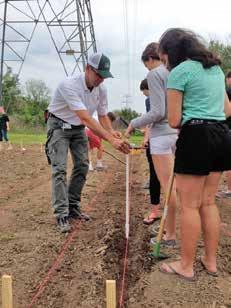
Chuck Crawford, an Advanced
Environmental
Science teacher
Placement
at
Dublin
Jerome High School creates a soybean and corn demonstration plot with his students.
GrowNextGen network to connect with teachers, farmers, agronomists and industry professionals to gain a better understanding on subject matter. The growing list of resources on GrowNextGen has helped Crawford develop lesson plans that integrate agriculture into the science classroom
GrowNextGen is a program sponsored by the Ohio Soybean Council (OSC) and Ohio’s soybean farmers. Through an online portal and outreach events, GrowNextGen provides Ohio’s agriscience and bioscience teachers with direct access to industry partners and a wide array of relevant soybean-related classroom materials, career videos, interactive eLearning courses and student research opportunities. More than 400 teachers, industry partners and students have profiles on the GrowNextGen.org website, making it the ideal place for learning and collaboration to occur around the topics of agriculture and science.
Crawford’s students physically planted five cultivars of soybeans and five cultivars of corn, and his intent is that students will be able to see what it takes to prepare soil, plant crops, and manage plants to maturity.
and give students a more interactive learning experience.
This May, Crawford partnered with DuPont Pioneer to create a demonstration plot near the school.
“The key to this whole demonstration plot is to allow students an authentic classroom experience with commodities that play such a vital role in our lives,” he said. Crawford’s students physically planted five cultivars of soybeans and five cultivars of corn, and his intent is that students will be able to see what it takes to prepare soil, plant crops, and manage plants to maturity. The students will be able to learn first-hand how pest management is addressed in the plot. They will study the chemicals cycling through the soil and observe how water affects the plant at every stage.
Not only is Crawford’s teaching method innovative, it is practical. The crops his class is growing now will produce a harvest in the fall. Crawford plans to use the yields from the demonstration plot as feedstock to produce biodiesel and ethanol as part of a unit on biofuels. Students in Crawford’s class benefit from experiencing the full life cycle of the soybean.

As soybean cyst nematodes have adapted to the most widely used source of genetic resistance, you increasingly need additional protection against SCN to maximize yield potential. Take back control with Clariva™ Complete Beans, the only seed treatment proven to offer effective, season-long protection against SCN through direct and lethal activity. Clariva Complete Beans helps minimize hidden and costly damage from SCN independent of environmental conditions, and builds on the unsurpassed early-season insect and disease protection that growers trust from market-leading CruiserMaxx® Beans with Vibrance® seed treatment.
Contact your Syngenta representative or visit ClarivaCompleteBeans.com and take back your fields.
